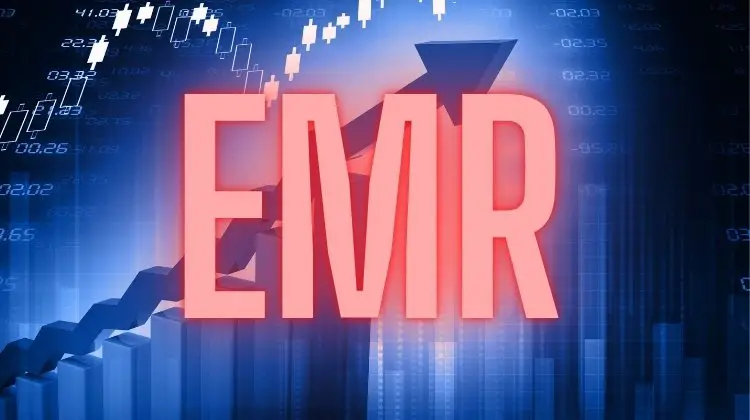
Emerson Electric (NYSE: EMR) announced a quarterly dividend increase to $0.555 per share on November 5, 2025, marking a 5.2% raise from the previous $0.528 per share. The dividend will be paid December 10, 2025 to shareholders of record as of November 14, 2025.
While this marks another year in Emerson’s 68-year dividend growth streak—cementing its status as a Dividend Aristocrat—the more interesting story lies beneath: a company in the middle of a massive portfolio transformation that has fundamentally changed its cash flow profile and dividend coverage.
The Cash Flow Picture: Strong Coverage With Room to Spare
Let’s start with what matters most for dividend sustainability: actual cash generation.
For fiscal 2025 (ended September 30), Emerson generated $3.676 billion in operating cash flow and $3.245 billion in free cash flow. Against total dividend payments of $1.192 billion, this translates to a free cash flow payout ratio of just 36.7%.
This is excellent coverage. The company is retaining nearly two-thirds of its free cash flow after paying dividends, providing substantial flexibility for reinvestment, debt management, and the newly authorized $50 million share repurchase program.
At the new quarterly rate of $0.555, Emerson’s annual dividend obligation sits at approximately $2.22 per share, or roughly $1.25 billion based on current share count. Against fiscal 2025’s free cash flow of $3.245 billion, the company could theoretically increase its dividend by another 160% before hitting a concerning 100% payout ratio.
Of course, management won’t do that—nor should they—but it illustrates the cushion available.
Earnings-Based Analysis: Conservative Payout on Adjusted Earnings
Looking at earnings-based metrics, Emerson reported adjusted earnings per share of $6.00 for fiscal 2025, representing 9% growth year-over-year. At an annual dividend of $2.22 per share, this produces a payout ratio of 37% on adjusted earnings.
This sits well below the typical 50-60% threshold where dividend safety concerns emerge, and it’s particularly conservative given Emerson’s mature, cash-generative industrial business model.
For context, the company’s guidance for fiscal 2026 calls for adjusted EPS of $6.35 to $6.55. Even at the midpoint of $6.45, the current dividend represents a payout ratio of approximately 34%—suggesting further runway for dividend increases without straining the balance sheet.
The Portfolio Transformation: From Diversified Conglomerate to Automation Specialist
What makes Emerson’s dividend particularly interesting right now is the dramatic business transformation underway. Over the past three years, the company has executed a series of major acquisitions and divestitures that fundamentally reshaped its portfolio:
Major Divestitures:
- Climate Technologies business (now Copeland) sold to Blackstone for $14 billion in May 2023, with Emerson initially retaining 40% equity. The remaining stake was sold in August 2024 for $1.5 billion.
- InSinkErator disposed for $3.0 billion in October 2022
Major Acquisitions:
- AspenTech: Completed buyout of remaining shares for $7.2 billion in March 2025, making it wholly owned
- National Instruments: Acquired for $8.2 billion in October 2023, creating the Test & Measurement segment
The result: Emerson has transformed from a diversified industrial conglomerate into a focused automation technology company with higher growth characteristics and stronger margin profiles.
This strategic shift is already showing up in the numbers. Adjusted segment EBITA margins expanded to 27.6% in fiscal 2025, up 160 basis points from 26.0% in fiscal 2024. The company is guiding for adjusted EBITA margins of approximately 26.0% in fiscal 2026, reflecting ongoing integration activities.
Capital Allocation Priorities: Balanced Approach to Shareholder Returns
In its fiscal 2026 outlook, Emerson outlined plans to return approximately $2.2 billion to shareholders through roughly $1 billion in share repurchases and $1.2 billion in dividends. This represents a meaningful shift toward capital returns after years of heavy acquisition spending.
The $1 billion buyback authorization signals management confidence in valuation and cash generation, while maintaining dividend growth as a priority. With net debt currently elevated following the AspenTech transaction, the company is balancing deleveraging with shareholder returns—a prudent approach that protects the dividend while optimizing the capital structure.
Business Fundamentals: Underlying Orders Point to Sustained Growth
Beyond the financial metrics, Emerson’s underlying business momentum supports continued dividend growth. The company reported 4% underlying orders growth for fiscal 2025, with particular strength in the Americas (6% growth). This marks three consecutive quarters of mid-single-digit underlying orders growth.
Management’s fiscal 2026 guidance calls for approximately 4% underlying sales growth and adjusted EPS growth of 6-9% (midpoint). This represents organic growth acceleration that should support ongoing dividend increases without requiring aggressive payout ratio expansion.
The Software and Control business—now representing approximately 32% of total sales—is showing particularly strong performance, with the Control Systems & Software segment posting a 33.0% adjusted EBITA margin in fiscal 2025.
Balance Sheet Considerations: Leverage Elevated But Manageable
One area requiring attention: Emerson’s leverage has increased following recent M&A activity. At September 30, 2025, the company held $13.1 billion in total debt (short and long-term) against $1.5 billion in cash, producing net debt of approximately $11.6 billion.
Against adjusted EBITA of roughly $4.7 billion for fiscal 2025, this represents a net debt-to-EBITDA ratio of approximately 2.5x—elevated but manageable for an investment-grade industrial. Management has indicated a focus on deleveraging, with strong free cash flow generation providing the means to reduce debt while maintaining dividend growth.
The company’s debt maturity profile shows $4.8 billion in short-term borrowings and current maturities, which will require refinancing or cash repayment in the near term. However, with $3.5-3.6 billion in projected free cash flow for fiscal 2026 and access to credit facilities, this poses minimal risk to the dividend.
Competitive Position and Market Opportunity
Emerson’s focused automation portfolio positions it well for several secular growth trends:
- Industrial digitalization and AI/ML adoption in manufacturing
- Energy transition and decarbonization efforts requiring advanced process control
- Reshoring and capacity expansion in critical industries
- Growing complexity in automated test and measurement
The company competes in fragmented markets where no single competitor offers Emerson’s breadth across intelligent devices, control systems, and optimization software. This positioning supports pricing power and margin stability—both critical for sustaining dividend growth.
5-Year Dividend Growth Scenarios: What Your Income Could Look Like
Let’s project where Emerson’s dividend could be in five years based on different growth assumptions. Given the company’s 37% payout ratio and strong free cash flow generation, these scenarios are all financially sustainable:
| Scenario | Annual Growth Rate | Current Quarterly | Year 5 Quarterly | Total Increase |
|---|---|---|---|---|
| Conservative | 3.0% | $0.555 | $0.643 | 15.9% |
| Base Case | 5.0% | $0.555 | $0.708 | 27.6% |
| Optimistic | 7.0% | $0.555 | $0.778 | 40.2% |
What This Means for Your Portfolio:
If you hold 100 shares of Emerson today, your quarterly dividend income would grow as follows:
- Conservative scenario: $55.50 today → $64.30 in five years (+$8.80/quarter)
- Base case scenario: $55.50 today → $70.80 in five years (+$15.30/quarter)
- Optimistic scenario: $55.50 today → $77.80 in five years (+$22.30/quarter)
The base case assumes Emerson maintains its recent 5.2% increase, which is supported by current payout ratios and management’s growth outlook. The conservative scenario accounts for potential economic headwinds or integration challenges, while the optimistic case reflects accelerated growth from successful portfolio transformation.
Given Emerson’s 37% payout ratio, even the optimistic scenario would only push the payout to approximately 50% of earnings—still well within sustainable territory for a mature industrial company.
The Bottom Line for Dividend Investors
Emerson’s 5.2% dividend increase reflects a company with strong cash generation, conservative payout ratios, and a transformed business mix positioned for higher growth and margins. The 68-year dividend growth streak appears secure, supported by:
- Free cash flow payout ratio of 37% with substantial coverage
- Adjusted earnings payout ratio of 37% with growth visibility
- Mid-single-digit revenue growth and margin expansion underway
- Strategic portfolio transformation toward higher-value markets
- Manageable leverage with deleveraging plans in place
For investors seeking exposure to industrial automation with reliable income, Emerson offers a compelling combination of yield (approximately 2.3% at current prices), dividend growth, and business transformation upside that most Dividend Aristocrats can’t match.
The key risk remains execution on the integration of National Instruments and AspenTech, along with general industrial cyclicality. However, the diversified end-market exposure and strong balance sheet provide cushion against near-term headwinds.
